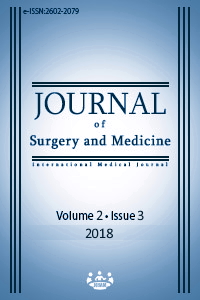Successful treatment of intussusception by hydrostatic reduction in pediatric patients: Is everything okay?
Keywords:
Misdiagnosis, Intussusception, Ultrasound guided hydrostatic reductionAbstract
Aim: Intussusception, which is defined as telescopic insertion of proximal bowel segment into distal bowel segment, can be cured completely with surgical intervention. Intussusception can be successfully treated by ultrasound guided hydrostatic reduction (USGHR) if there is no necrosis or perforations of intestines. However, misdiagnosing or omitting secondary conditions which can be seen together with intussusception leads to an inevitable rise in morbidity. In this study, we would like to present a retrospective review of the intussusception patients which developed complications due to misdiagnosis within a pediatric surgery clinic in terms of diagnosis and treatment.
Methods: 12 patients who were treated for intussusception using USGHR between May 2014 and September 2017 in Van Yuzuncu Yil University Faculty of Medicine Pediatric Surgery Department were retrospectively reviewed for missed conditions and coincidental pathologies. The data about these case series such as age, sex, patient symptoms, diagnosis and treatment methods, complications and hospitalization periods were evaluated.
Results: 12 (5 Female – 7 Male) patients, who were diagnosed with invagination with complaints of abdominal pain, refractory emesis, crying attacks, bloody stool and abdominal distension that treated with USGHR with a mean age of 34 (Range 6 – 98) months, showed a worse clinical prognosis due to missed secondary conditions. Missed secondary pathologies included appendicitis (3 cases), lymphoma (1 case), Meckel diverticulitis (1 case), appendiceal intussusception (3 cases), acute gastroenteritis (3 cases) and Henoch-Schonlein Purpura (1 case). The patient with Henoch-Schonlein purpura diagnosis was treated with USGHR in combination with corticosteroids and all the other cases required open surgery. Follow-up of the patient with Henoch-Schonlein purpura is ongoing whereas all the other cases were treated successfully.
Conclusion: Although most intussusception cases are successfully treated with non-surgical USGHR treatments in our pediatric surgery clinic, missing the conditions that are seen with invagination causes an increase in surgical intervention rates, morbidity rates and medical costs. The main challenge for pediatric surgeons in invagination cases caused by pathological leading point conditions is the possibility of missing the actual underlying disease which caused the invagination following a successful USGHR after target-sign is detected. Although ultrasound and computed tomography studies might be helpful in preliminary diagnosis, it must be kept in mind that an actual diagnosis can only be done with surgery in some cases.
Downloads
References
Chua JHY, Chui CH, Jacobsen AS. Role of surgery in the era of highly successful air enema reduction of intussusception. Asian Journal of Surgery. 2006;29(4):267-73.
Lin XK, Xia QZ, Huang XZ, Han YJ, He GR, Zheng N. Clinical characteristics of intussusception secondary to pathologic lead points in children: a single-center experience with 65 cases, Pediatr Surg Int. 2017;33(7):793-7.
Yao XM, Chen ZL, Shen DL. Risk factors for pediatric intussusception complicated by loss of intestine viability in China from June 2009 to May 2014: a retrospective study, Pediatr Surg Int. 2015; 31(2):163–6.
Wang Z, He Q, Zhang H, Zhong W, Xiao W, Lu L. Intussusception patients older than 1 year tend to have early recurrence after pneumatic enema reduction. Pediatr Surg Int. 2015;31(9):855–8.
Kee HM, Park DM, Lim JY, Yi DY, Lim IS. A Case of Intussusception with Acute Appendicitis. Pediatr Gastroenterol Hepatol Nutr. 2015;18(2):134-7.
Mensah Y, Glover Addy H, Etwire V, Appeadu Mensah W, Twum M. Ultrasound guided hydrostatic reduction of intussusception in children at Korle Bu Teaching Hospital: An initial experience. Ghana Med J. 2011;45(3):128–31.
Morsi AH, Ahmed O, Ahmed RK. Adding a custom made pressure release valve during air enema for intussusception: A new technique. African Journal of Paediatric Surgery. 2015;12(4):232.
Esposito F, Ambrosio C, DeFronzo S, Panico MR. Fluoroscopy-guided hydrostatic reduction of intussusception in infancy: role of pharmacological premedication. La Radiologia Medica. 2015;120(6):549-56.
Vazquez JL, Ortiz M, Doniz MC, Montero M, Del Campo VM. External manual reduction of paediatric idiopathic ileocolic intussusception with US assistance: a new, standardised, effective and safe manoeuvre. Pediatr Radiol. 2012;42(10):1197–204.
Hagan I, Con C, Shepher N, McGann G. Acute suppurative appendicitis complicating ileocolic intussusception due to a caecal lipoma. European Journal of Radiology Extra. 2006;60(3):113-5.
Chang TP, Russell SA. Perforated appendicitis and appendicolith in a child presenting as intussusception: a case report. Pediatr Emerg Care. 2011;27(7):635-8.
Newman B, Schmitz M, Gawande R, Vasanawala S, Barth R. Perforated appendicitis: an underappreciated mimic of intussusception on ultrasound. Pediatr Radiol. 2014;44(5):535–41.
Jonah L, Verhey P, Dobos N. Preoperative CT diagnosis of appendiceal intussusception. American Journal of Roentgenology. 2006;187(3):325-6.
Tavakkoli H, Sadrkabir SM, Mahzouni P. Colonoscopic diagnosis of appendiceal intussusception in a patient with intermittent abdominal pain: a case report. World journal of gastroenterology. 2007;13(31):4274.
Ocal S, Cevik M, Boleken ME. A comparison of manual versus hydrostatic reduction in children with intussusception: Single-center experience. African Journal of Paediatric Surgery. 2014;11(2):184.
England RJ, Pillay K, Davidson A, Numanoglu A. Intussusception as a presenting feature of Burkitt lymphoma: implications for management and outcome. Pediatric surgery international. 2012;28(3):267-70.
Cull DL, Rosario V, Lally KP, Ratner I, Mahour GH. Surgical implications of Henoch. Schönlein purpura. J Pediatr Surg. 1990;25(7):741-3.
Peru H, Soylemezoglu O, Bakkaloglu SA, Peru H, Elmas S. Henoch Schonlein purpura in childhood: clinical analysis of 254 cases over a 3-year period. Clin Rheumatol. 2008;27(9):1087-92.
Downloads
- 1899 2559
Published
Issue
Section
How to Cite
License
Copyright (c) 2018 Burhan Beger
This work is licensed under a Creative Commons Attribution-NonCommercial-NoDerivatives 4.0 International License.
















